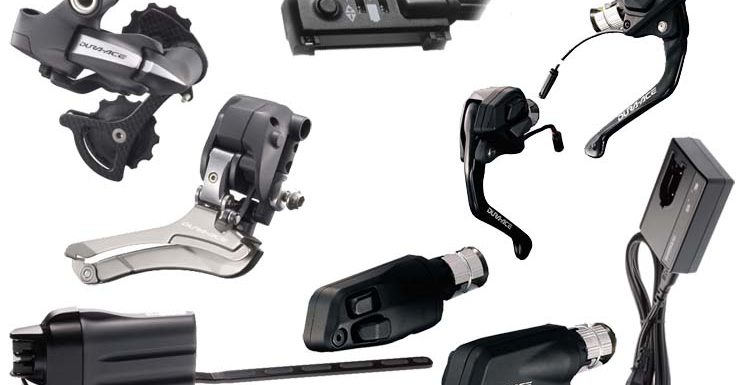
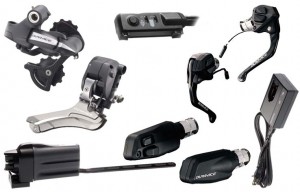 I learned quite a bit about Shimano Di2 when I installed one of the first available Time Trial/Triathlon groupsets on my Cervelo P2. I’ve subsequently answered a lot of questions on forums and article comments, and elsewhere. In doing so, I realized that people have a lot of questions about Di2 and the answers are difficult to find. This lead me to create this article, to consolidate everything I know and have been asked into one location so people can find answers. If you can’t find what you’re looking for below, please leave a comment and I’ll do my best to help.
I learned quite a bit about Shimano Di2 when I installed one of the first available Time Trial/Triathlon groupsets on my Cervelo P2. I’ve subsequently answered a lot of questions on forums and article comments, and elsewhere. In doing so, I realized that people have a lot of questions about Di2 and the answers are difficult to find. This lead me to create this article, to consolidate everything I know and have been asked into one location so people can find answers. If you can’t find what you’re looking for below, please leave a comment and I’ll do my best to help.
Index: There’s lots of info in this post, so here’s an Index to help you find specific sections:
- Di2 General Overview
- Compatibility: Between 6770 10-speed, 6780 11-speed, 9070 11-speed, first-gen 7970
- How to Check Battery Level
- How to Adjust Rear Derailleur Trim
- How to Adjust Front Derailleur Trim
- Dealer Installation Manuals
- Shimano E-tube Project Software – Change Settings and Update Firmware
- Chargers, PC USB Interfaces/Programmers
- Component Overviews
- Shift/Brake Levers
- Dedicated Shift Buttons
- Front Derailleurs
- Rear Derailleurs
- Display Units and ANT Bluetooth Wireless Communication Modules
- Batteries and Battery Mounts (Internal and External)
- Front Cable Connection A Junctions (with charger ports and LED status lights)
- Rear Cable Connect B Junctions
- Cables, Grommets, Cable Install Tools
- List of Components Needed to Build Your Own Di2 System
- Technical Details of the Di2 CANBUS protocol and signaling
System Overview: Shimano Di2 Dura-Ace 9150 and 9070 and Ultegra 6770 and 6870
The second generation Shimano Ultegra 6770/6870 and Dura-Ace 9070 “E-Tube” electronic bicycle shifting systems consist of battery-powered electric derailleurs activated by handlebar mounted push buttons. Power and shift commands are sent via a 2-wire CAN (Controller Area Network) datalink contained within a single cable housing. This design has several advantages over conventional mechanical shifting systems, the most notable of which are:
- Extremely low shifting effort, which generally results in more frequent shifts and therefore better gear ratio selection.
- Greatly improved shift quality, especially for the front derailleur chainrings, allowing shifting under full power with almost no chance of a dropped chain.
- Shifting is available at multiple positions on the handlebars, for example, at the end of the time trial aero bars, on the brake levers, up to in climbing position, and down low the sprint position.
- Automatic trimming of the front derailleur position as the rear derailleur moves back and forth between the smaller and bigger gears. This eliminates unintended contact (and noise) between the front derailleur and the chain.
- Lighter weight vs. equivalent mechanical system. The Shimano Dura-Ace Di2 9070 electronic groupset with internal battery weighs 2047 grams; the Shimano Dura-Ace 9000 mechanical groupset weighs 2074 grams (27 grams more than Di2.)
- Multi-Shift: Pressing and holding a rear derailleur shift button results in shifts through multiple gears. The rate of shifts can be configured using the PC computer interface cable and the free Shimano E-tube Project software.
- Synchronized Shifting: Starting with Dura-Ace 9150, automated Synchronized Sifting of the front derailleur is an option. Two SHIMANO Synchronized Shift modes will be available:
- Full SHIMANO Synchronized Shift: the front derailleur reacts based on the rear derailleur’s shift action. This essentially means that, when activated, there is no need for two separate shifters to control front and rear derailleurs, the two buttons on one shifter will control both derailleurs.
- Semi SHIMANO Synchronized Shift mode: the rear derailleur reacts based on the front derailleur’s shift action, shifting to the next most appropriate rear gear when the rider makes a front shift.
- R9120, R9170 – syncroshift enabled with firmware 3.2.0 or newer
- 6870, 9070 – syncroshift enabled with firmware 3.2.1 or newer
- 6770 – no syncroshift firmware update will be offered
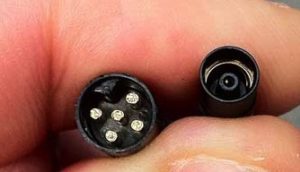 Historic Info on the older first generation 5-wire Shimano Dura-Ace Di2 DA-7970 system and how it compares to the new E-tube 2-wire system:
Historic Info on the older first generation 5-wire Shimano Dura-Ace Di2 DA-7970 system and how it compares to the new E-tube 2-wire system:
Released in 2009, the 7970 operated using a very basic 5-wire electronic system. Each shift button was connected to a different wire; shorting the specific wires together controlled the derailleur upshifts and downshifts. Because the first generation 7970 used completely different technologies than the newer 2-wire systems, none of the components are cross-compatible. At this point, Shimano is not expected to offer any updates or new components using the first generation 7970 architecture; everything from now on will be based on the newer 2-wire E-tube design. The second generation design offers several advantages, which include: 1) smaller wire size, smaller connector size, waterproof connectors; 2) all switches can be reconfigured in software to send upshift or downshift commands to either the front or rear derailleur; 3) firmware updates can add new features (such as multi-shift) and compatibility with new components.
Compatibility: Dura-Ace 9070 and Ultegra 6770 / 6870 (and old 5-conducter 7970)
The confusing naming system used by Shimano makes it difficult to figure out what each component is, much less what is compatible between systems. Here are some compatibility guidelines:
- Nothing from the first generation (4-conductor / 5-conductor) Dura-Ace Di2 7970 system is compatible with any other newer system. It was replaced by the (2-conductor) E-tube systems. No parts are inter-operable between 7970 and any other Di2 System.
- In general, every electronic Di2 component is compatible between the Ultegra 6770, 6870, and Dura-Ace 9070 systems (see exceptions below.) This means that all of the road bike Ultegra/Dura-Ace dual control brake levers/shifts, time trial shifters, and climbing shifters can be used with either Ultegra 6770/6870 or Dura-Ace 9070 front and rear derailleurs. Any of the Ultegra/Dura-Ace controllers (A Junctions) can be used with either system. All components use the same cables and connectors.
- Firmware Update Required to Make Older Components Compatible with Newer Components: If you add a new component and it doesn’t work, update the firmware using the PC USB adapter and the Shimano E-tube Project Software for Windows.
- Synchronized Shifting and Bluetooth Wireless Units can be added to all E-tube Ultegra and Dura-Ace systems but the battery has to be upgraded to the BT-DN110 Internal Battery or BM-DN100 External Battery Mount. To add Bluetooth capability, a EW-WU101 or EW-WU111 inline transmitter must be added to road bikes and for mountain bikes, the SC-MT800 or SC-M9051 display/transmitter unit must be added.
- Compatibility Exceptions:
- Note 1 – Sprint Shifter Exception: The Sprint Shifter is the only exception for shifter incompatibility. It has a different wiring connector (and internal components) that can only plug into a unique/dedicated third port on the Dura-Ace ST-9070 Dual Control Brake Levers/Shifters and also the ST-6870 Levers. There is no sprint shifter port on the ST-R785 Hydraulic Levers.
- Note 2 – Can’t mix 10-speed/11-speed front/rear Derailleurs: It is no longer possible to use a 10-speed front derailleur with an 11-speed rear derailleur (and 11-speed front with 10-speed rear.) See note farther below to read the history on this if you want all the messy details.
- Note 3 – Front A junction and Internal Battery: Since the February 2015 firmware update, the older SM-EW67-A-E Front Junction A is no longer compatible with the BTR2 Internal Battery because it does not have the charging port to charge the internal battery. The SM-EW90 Front Junction (with integrated charging port) should be used instead. The SM-EW67 still works with the external battery.
- Note 4 – Update the Firmware to make components compatible: If the firmware on all components is not updated to the latest version, some components may be not operate correctly with one another. So download the latest E-tube software and update everything and it should work.
- Note 5 – All Shifters work with all 10-speed and/or 11-speed Rear Derailleurs: All of the shifters are compatible with either the 10-speed Ultegra 6770 or 11-speed Ultegra 6870/Dura-Ace 9070 systems as long as they all have the latest firmware. The rear derailleur is the only component that “knows” or “cares” how many rear gears are available. The shifters only send upshift/downshift commands and do not “know” or “care” which gear is currently selected and how many total gears there are.
- Note 6 – SM-BTR1 External Battery and SM-BMR1 Mount firmware updates: The more expensive dedicate service tool (SM-PCE1 PC Interface) must be used to upgrade the firmware on the external battery/mount.The external battery and battery mount can not receive firmware upgrades via the SM-EW90 Front Junction A and the SM-BCR2 PC Interface/Battery Charger. (The SM-EW90 will work in a system with an external battery, but a firmware update can cause them to become incompatible until both are updated independently using the appropriate PC Interface and the Shimano E-Tube Project software.)
- See the Shimano E-tube compatibility chart version 3.4.3 for more details
Compatibility: 11-Speed Rear Derailleur and 10-speed sprockets/wheels
The 11-speed Dura-Ace 9070 and Ultegra 6870 rear derailleurs are designed exclusively for 11-speed rear sprockets and 11-speed Front Derailleurs. Shimano does not provide a way to recalibrate/reprogram them for a 10-speed setup. The sprocket spacing is slightly smaller and the overall range of travel slightly longer on 11-speed systems. If you have 10-speed wheels and 10-speed sprockets, you should use the 10-speed RD-6770 rear derailleur and a 10-speed FD-6770 front derailleur.
Similarly, a 10-speed RD-6770 rear derailleur should not be used with 11-speed sprockets. There will be chatter in some gears, and there might be slow-shifts or self-shifts.
It doesn’t matter which shifters are used; the shifters send upshift/downshift commands regardless of which derailleur config is being used. Shifters do not “know” or “care” which gear is currently selected and how many total gears there are.
Front Chain Rings: In general, most any front chain rings will work, rigid forged rings work best with Di2 due to high front derailleur shift forces. Shimano chain rings tend to be the best, but most others work as well. A 10-speed specific or 11-speed specific chain should be used, but the differences between them are minimal and can generally be mixed/matched without issue.
How to convert “non-upgradeable 10-speed only” wheels such as Zipp 900/Sub9 Disc Wheels to 11-speed: “the spacing between a Campy 11 and Shimano 11 is close enough that you can use the cassettes interchangeably. If you get a Campy free hub body, the 2 shims (part# is on the Zipp website, just search for Campagnolo 11) and a Campy cassette and you’re ready to ride with all 11 cogs available to use.” via slowtwitch.com
But it’s an emergency and I need to use a 10-speed wheel. . . In emergency situations, 11-speed rear derailleurs can be used with 10-speed sprockets. There will probably be chatter in some gears, and there might be slow-shifts or self-shifts. To setup an 11-speed rear derailleur for a 10-speed sprocket setup, adjust the mechanical limit screw so that it can’t shift into the missing 11th sprocket position, then follow the rear derailleur adjustment procedures listed below.
Included for very motivated individuals only: 10-speed front derailleurs can be used with 11-speed rear derailleurs if the shifters and battery have firmware installed from E-tube software version 2.5.2 or earlier. Shimano disabled support for this 11-speed and 10-speed cross-matching with later firmware updates. For informational purposes only, the details of how to regain compatibility are detailed below.
- Important Notice 2014-07-14: There is a compatibility issue with Shimano e-Tube software/firmware versions v2.6.0 and later that prevents 10-speed front derailleurs (FD-6770) from working with 11-speed rear derailleurs (RD-6870) and 11-speed front derailleurs (FD-6870) from working with 10-speed rear derailleurs (RD-6770). DO NOT UPDATE FIRMWARE using Shimano e-Tube software v2.6.0 or later if you are mixing an FD-6770 front derailleur and a RD-6870 11-speed rear derailleur, or a FD-6870 with a RD-6770.
- The problem component is the battery (external battery mounts SM-BMR1 and SM-BMR2, internal seat post battery SM-BTR2.) If you keep battery firmware at v2.0.6 or earlier, the system will continue to function properly. Shimano e-Tube Software v2.6.0 will update battery firmware to v3.0.5, and will not allow the RD-6870 to work with a FD-6770 setup.
- If the battery firmware is updated to 3.0.5, it CAN NOT be rewritten back to the older version. You will need to need to replace a derailleur so that both are 6770 10-speed or so that that both are 6870 11-speed. (The other option is to get get a battery with the older firmware and never update it.)
- Here’s a link to the “last known good version” of the Shimano e-Tube software to work with a mixed 10-speed/11-speed system: E-tube_Proj_V_2_5_2.zip Use this version and do not connect to the internet when using it so that E-tube can’t check for updates when open.
- To roll-back newer versions of battery and shifter firmware, install E-tube version 2.5.2 and made a copy of “C:\ProgramData\E-tube Project\FW” which has all the firmwares packaged in that version of E-tube. Next, install the latest version of E-tube. Then copy all the firmwares from the the 2.2.3 version back to the same location “C:\ProgramData\E-tube Project\FW” for the latest version (note: ProgramData is a hidden directory, click here for details on how to view it.). Next, the trick is to find the firmware you want to downgrade (pretty easy from the name and version in the file name), and then rename it to the same name as the latest version, but increment the last version digit by one. Then connect to the bike with E-tube (without an internet connection) and it will identify that a firmware upgrade is available for that component and allow you to do the firmware “upgrade” to the older version of firmware. Now exit E-tube and then rename the firmware file back to original to prevent the issue in future. E-tube will then try to upgrade again but just don’t let it do that. This should get a bike that did nothing (not even enter adjustment mode) to a fully working state by reverting the battery and shifters. Running latest firmware in derailleurs seems to be fine. (thanks to commenter vosadrain)
- It will not be possible to charge the BTR2 internal battery using the BCR2 USB charger unless you also downgrade the firmware of the BCR2 USB charger as well.
- Note however that latest E-tube software will say the setup is unsupported and will not allow programming. To do programming, disconnect the internal battery and connect a spare external battery. This allows making settings changes. To program the BTR2 itself, I just connect to the BTR2 by itself (no other components) and the E-tube software will allow firmware changes to it. Or try using the 2.5.2 version of E-tube.
- Alternatively, buy a Di2DIY internal seat post battery kit and you will not have to go through the firmware downgrading. The kit makes it possible to run all components with the latest E-tube firmware. Also worth noting some firmware updates were done to fix power distribution errors in the FPGA’s that would allow the batteries to drain down when the bike was just sitting.
Checking Battery Charge Level:
A single battery charge should give at least 1500 miles of riding. Most riders will not need to charge the battery more than twice a year.
To check the battery charge remaining, press and hold any shifting switch for 0.5 seconds or more. The amount of battery charge remaining will be indicated by the light on Front Controller A Junction.
- 100% remaining: Illuminates green (for 2 seconds)
- 50% remaining: Flashes green (5 times)
- 25% remaining: Illuminates red (for 2 seconds)
- 0% remaining: Flashes red (5 times)
When the battery charge is low, first the front derailleur will stop operating, and then the rear derailleur will stop operating. When the battery charge has been fully spent, the derailleurs will be fixed at the last gear shifting position. If the battery indicator is illuminated red, it is recommended that you recharge the battery as soon as possible.
Adjusting the Rear Derailleur Trim:
If you switch between multiple rear wheels, it’s very likely that the sprockets on different wheels won’t be in exactly the same relative position to the rear derailleur, resulting in that annoying clicking sound as the chain makes contact with an adjacent sprocket. Follow the steps below to properly align the rear derailleur with the rear sprockets.
- Shift the rear derailleur to the 5th sprocket position. Press the button at the junction (A) of the SM-EW67-A-E until the red LED illuminates in order to switch to rear derailleur adjustment mode. Note that if you keep pressing the button after the red LED has illuminated, protection recovery operation will begin.
- If shifting switch is pressed once while the initial setting condition is active, the guide pulley will move one step toward the inside. If shifting switch (Y) is pressed once, the guide pulley will move one step toward the outside.
- Note: The guide pulley can move 15 steps inward and 15 steps outward from the initial position, for a total of 31 positions.
- Note: When adjusting, the guide pulley will overrun slightly and then move back in an exaggerated movement so that you can check the adjustment direction. When checking the positions of the guide pulley and the sprocket, check at the position where the guide pulley finally stops.
- While turning the front chainwheel, operate shifting switch to move the guide pulley toward the inside until the chain touches the 4th sprocket and makes a slight noise.
- Next, operate shifting switch 4 times to move the guide pulley toward the outside by 4 steps to the target position.
- Press the button at junction (A) until the red LED turns off in order to switch from rear derailleur adjustment mode to gear shifting mode. Shift to each gear and check that no noise is generated at any gear position. If fine adjustment is needed, switch back to adjustment mode and readjust the rear derailleur.
- Note: if you have customized your shifters and swapped buttons, this will change which shifter and buttons control the micro-adjustments. Also, if you hit the wrong buttons while trying to set the FD trim, you can actually alter the setup of your RD. Be certain that you’re hitting the correct adjustment buttons.
- If you have a Garmin or similar head unit and a SM-EWW01 ANT module, the display will automatically switch into derailleur trim display when you activate that mode (i.e. by pressing the button at the junction (A) of the SM-EW67-A-E.) It will give you the trim position in either + or – 12 positions. When switching wheels, simply take note which position suits which wheel/sprocket/trainer, and trim to that level each time you change. This removes the guesswork and makes changing from wheel to trainer simple.
Note on FD-6870 Front Derailleur Trim:
The FD-6870 trim adjustment effects the auto-trim positions. The adjustment feature is accessible via either the A-Junction box, or the “Front derailleur adjustment setting” in the e-tube software, and should be used only after you have already set the physical inner/outer limit screws. So for example, if the FD outer plate rubs the chain when using the 6th largest cog, you would want to adjust the FD trim outward a couple ticks. However, you can only perform this adjustment while in the big-ring/big-cog combination. Etube forces the derailleurs into this maximum cross-chained position, whereas during the manual method you must shift to these positions yourself. (Thanks to commenter Bryan B for the info.)
Dealer Manuals:
The dealer’s manuals contain the most detailed information available from Shimano. If you’re looking for detailed installation instructions, check here:
- Shimano Ultegra 6770 Dealer’s Manual: http://techdocs.shimano.com/media/techdocs/content/cycle/SI/Ultegra/UltegraDi2/6770Di2_DM_EN_v1_m56577569830773882.pdf
- Shimano Ultegra 6870 Dealer’s Manual: http://si.shimano.com/php/download.php?file=pdf/dm/DM-UL0001-00-ENG.pdf
- Shimano Dura-Ace 9070 Dealer’s Manual: http://si.shimano.com/pdf/dm/DM-DA0001-00-ENG.pdf
- Shimano Alfine Di2: http://si.shimano.com/php/download.php?file=pdf/dm/DM-AL0001-03-ENG.pdf
Shimano E-tube Project Configuration and Firmware Update Software for Windows:
Shimano E-tube Project Wireless for iOS and Android: Announced on April 15, 2016 but as of yet unreleased, these apps will allow configuration of shift profiles (multi-shift on/off, multi-shift delay between shifts, shifter button assignments) and firmware updates over Bluetooth. To function, a Shimano Di2 Bluetooth Adapter, such as the MT800 digital display, is required.
Shimano E-tube Project Windows PC Software: This free software is used to update the firmware of all components. It works with the SM-BCR2 Charger + USB Adapter and the SM-PCE1 Diagnostic Adapter. The software is used to change the configuration of each shift button / lever (any can be programmed to upshift or downshift either the front or the rear derailleur.) It can also be used to enable multi-shift (multi-shift is where the shifter is held and the rear derailleur shifts through multiple gears until the shifter is released.) The delay between of the gear changes during multi-shifting can also be adjusted. The software is available from http://e-tubeproject.shimano.com/
Older versions of the e-tube software are available from these links: 2.5.2
PC & Mobile Interfaces, Chargers, and Software:
SM-BCR1 Battery Charger: This is used to charge the external battery. The part number for the battery charger wall cord is SM-BCC1.
SM-BCR2 Charging and PC Connection: for SM-EW90-A 3-port and SM-EW90-B 5-port A Junctions. This plugs into a special port on the side of the A junctions (which is covered by a rubber flap.) This adapter charges the internal battery when first plugged into the A junction; it must be powered by a standard USB Wall charger (such as that used for an Apple iPhone) or a PC that is powered-on. If the Shimano E-Tube Project Software is launched on the Windows PC with the SM-BCR2 attached, the SM-BCR2 will switch from charging mode to configuration mode. It must be detached from the computer and reattached to switch back to charging mode.
- It takes about 2 hours to charge the internal battery.
- Amber light=charging.
- Light turns off when done.
- If the Amber light does not come on when plugged in, this indicates battery is not discharged enough to charge.
- Light flashing indicates something is wrong, like trying to charge a external battery through a BMR.
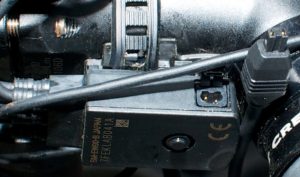
Hacking the SM-BCR2 to have a standard Di2 cable connector: If your 3-port or 5-port junction is inaccessible for charging, there is an alternative hack method to connect it to the system through a standard Di2 port. With basic soldering skills you can hack the BCR2 to be used with any setup. Buy any length EW-SD50 wire, cut off one end. Cut the wire on the output side of the BCR2. Splice the two wires together, so that the output wire of the BCR2 is now a standard Di2 connector. The charger has an inner (white) and outer (shield) wire; connect the inner white wire to the SD50 red wire; connect the charger outer shield wire to the SD50 black wire. You will then be able to plug the BCR2 into any Di2 port. Or use a SM-JC40 junction B and another length of EW-SD50 wire and go through the RD (by using the SM-JC40 to connect the rear derailleur, new output wire of the EW-SD50, and the wire that ordinarily connect the rest of the system to the rear derailleur.) Thanks to @Di2diy for the info.
SM-PCE1: This PC Configuration and Diagnostics adapter will not charge the internal battery. It offers the same configuration options as the SM-BCR2, but also add some advanced diagnostic and troubleshooting features that the SM-BCR2 does not have. It attaches to via the standard E-tube wire (just like the EW-SD50 cables) rather than to a dedicated port on the side of the front A junction.
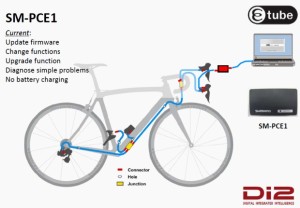
Bluetooth and E-tube Apps for Apple iOS and Android: Bluetooth wireless modules are available to allow system settings to be adjusted via the mobile applications that connect via Bluetooth Adapters.
Component Overview:
The confusing naming system used by Shimano makes it difficult to figure out what each component is, much less what it does and how it fits into an a complete Di2 system. Here’s an overview of all the major Ultegra and Dura-Ace Di2 components.
Dual Control Brake Levers/Shifters (a.k.a. Brifters):
ST-6770 Ultegra Road Dual Control Brake Levers/Shifters: The Ultegra version can be used with the climbing shifters. They are sold in in left/right pairs and are also available separately.
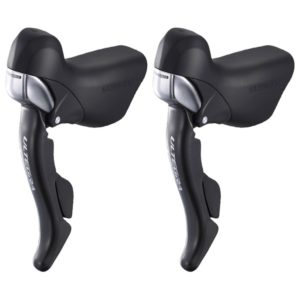
ST-9070 Dura-Ace Road Dual Control Brake Levers/Shifters: The main advantages these have over the ST-6770 version is slightly lighter weight and compatibility with the low-mount sprint shifters. As like the Ultegra version, they are compatible with the climbing shifters. They also have hidden button under the rubber hoods that can activate screen changes on cycling computers from Garmin, Magellan, Pioneer, and Shimano (Shimano SM-EWW01 ANT Wireless Broadcast Module required.)
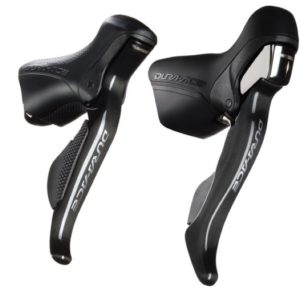
ST-9071 Dura-Ace Time Trial/Triathlon Dual Control Brake Levers/Shifters: These levers provide shifting from the pursuit bar position on time trial bikes. There is no Ultegra option offered at this time. These are available as left/right pairs, or can be ordered separately. These do have a permanently attached wire with a male end for connection the the SM-EW90 front “A” junction. Combined weight both levers: 117 grams.
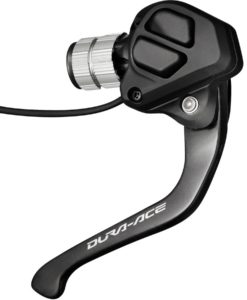
ST-R9160 (standard cable brakes) and ST-R9180 (hydraulic brakes) Time Trial Dual Control Brake Levels/Shifters: These are the lower-profile shifters offered with the newer Dura-Ace R9150 groupset.
ST-6871 Ultegra Time Trial/Triathlon Dual Control Brake Levers/Shifters: Ultegra version of the ST-9071 Dura-Ace shifters. Slightly heavier and much less expensive than the Dura-Ace version. Combined weight both levers: 142 grams.
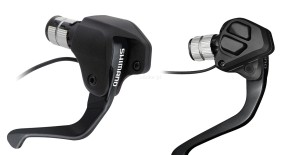
ST-R785 Hydraulic Road Dual Control Brake Levers/Shifters: These hydraulic road shifters are compatible with both the climbing and sprint shifters. These are compatible with the SM-RT99 centerlock 140mm and 160mm rotors and WH-RX31 wheelset (which as no standard rim brake track.) These require the BR-785 dual piston hydraulic disc calipers. They do not have the special wiring port required for the SW-R610 Sprint Shifters and a SM-EW90-B 5-port junction A is required to use the SW-R600 climbing shifter.
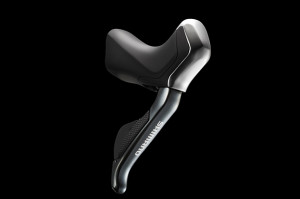
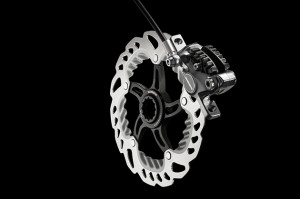
ST-6870 Ultegra Road Dual Control Brake Levers/Shifters: These road shifters are compatible with both the climbing and sprint shifters.
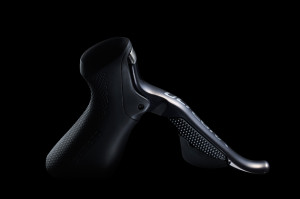
Dedicated Shifters:
SW-R671 Dura-Ace 2-Button Time Trial/Triathlon Bar End Shifters: These shifters are installed on the end of time trial aero bars. By default, the left shifter upshifts/downshifts the front derailleur; the right controls the rear derailleur. For both, the lower button upshifts into a harder gear and the upper button downshifts to an easier gear. This can be changed using the Shimano E-tube Project software; the functions of the left and right sifters can be switched with one another as well. These are available in pairs or separately.
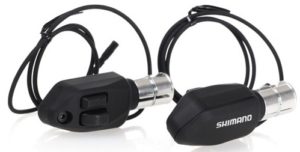
SW-9071 Dura-Ace 1-Button Time Trial/Triathlon Bar End Shifters: These shifters have only one button each and are intended to control only the rear derailleur, with one sending the upshift command and the other the downshift command. (I personally think this version is absolutely worthless. Why have 2 SW-9071 shifters at twice the price and twice the weight, when you can just buy a single SW-R671 Right shifter instead.)
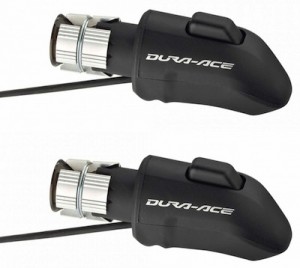
SW-R600 Climbing/PAVE Shifter: This shifter is for road bikes and is mounted on the upper horizontal portion of the handlebar, or any other location comfortable for the rider. They can be used in addition to the Dual Control Brake Lever/Shifter, or can be used on their own by plugging directly into a SM-EW90-A 3-Port Junction or SM-EW90-B Dura-Ace 5-Port Junction.
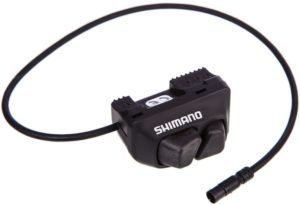
SW-R610 Dura-Ace Sprint Shifter: This is the only component using a unique wiring connector; it is only compatible with the ST-9070 Dura-Ace and Ultegra ST-6870 Road Dual Control Brake Levers/Shifters. Unlike all of the other shifters, the sprint shifters do not contain a circuit board; they do not show up as components on the CAN bus network. Instead, the sprint shifters are simple momentary switches that activate the circuit board on the host Dual Control Brake Lever/Shifter. The host dual control lever is what sends the shift command. (Note: Any momentary switch can be attached to the sprint shifter port on the Dual Control Levers by splicing into a standard EW-SD50 wire to act as remote shifters.)
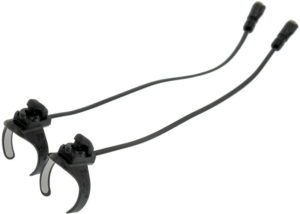
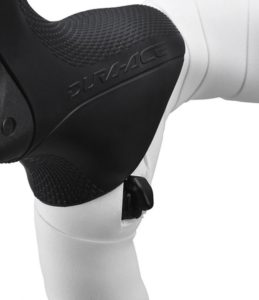
Alfine SW-S705 Right Flat-Bar Shifter: Reported to work with other non-Alfine setups.
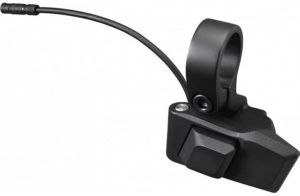
SW-R9160 Time Trial bar-end shifters (pair): These are-end shifters directly control the rear derailleur, with one for the upshfit and one for the downshift. The front derailleur is controlled automatically via automatic Synchronized Shifting. These shifters require the BT-DN110 Internal Battery for synchronized shifting.
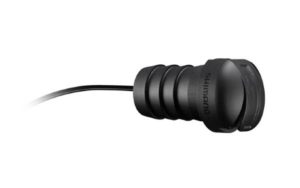
SW-R9150 Climbing shifters (pair): These tiny climbing shifters are about as small as the sprint shifters, but can be directly connected to a junction box and do not have to be connected as slave buttons to a brake/shift lever special port. They come with plastic mounts to make it easier to attach to bars beneath bar tape. They are ideal for synchronized shifting, with one controlling the upshifts and the other downshifts. These shifters require the BT-DN110 Internal Battery for synchronized shifting.
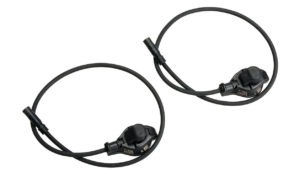

Front Derailleurs:
FD-6770: Ultegra Front Derailleur
FD-6870: Ultegra Front Derailleur, pretty much identical to the FD-6770 but with a slightly larger diameter adjusting screw (to better dissipate the shifting forces).
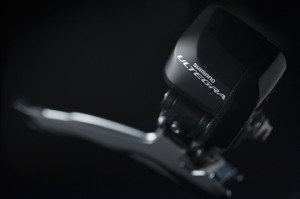
FD-9070: Dura-Ace Front Derailleur
FD-R9150: Dura-Ace Front Derailleur for 9150 systems; features slightly reduced weight vs. 9070.
Rear Derailleurs:
RD-6770: Ultegra 10-Speed Rear Derailleur, compatible with gears up to 28 teeth.
RD-6870: Ultegra 11-Speed Rear Derailleur, compatible with gears up to 32 teeth (for the GS version).
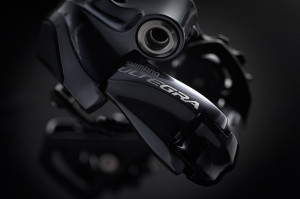
RD-9070: Dura-Ace 11-Speed Rear Derailleur, lighter weight version on which the RD-6870 is based.
RD-R9150: Dura-Ace 11-Speed Rear Derailleur with 30-tooth sprocket compatibility and modified “Shadow RD” geometry to keep the mechanism close to the rear wheel to help avoid damage in the event of an accident.
Alfine SG-S505 and SG-S705: The Shimano series targets comfort and urban bikes. It uses an 8-speed (505) or 11-speed (705) internal epicyclic rear hub. It is believed to be compatible with other Di2 ETube components but this has not been verified.
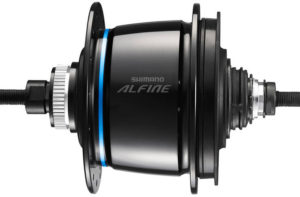
Display / Wireless Communication:
SM-EWW01 ANT Wireless Broadcast Module: This module wirelessly broadcasts Di2 data (front and rear gear selection details, gear ratio, battery life) to a cycling computer using the ANT protocol. It is compatible with Dura-Ace 9070, Ultegra 6870 Di2 and Ultegra 6770 E-tube road shifting systems. SM-EWW01 plugs into the E-tube wiring system between existing components. It has an 2 wiring ports, so it can be connected between a front shifter and the Front Junction A, or at the rear derailleur (between rear derailleur and Etube wire.) It transmits through a proprietary private ANT wireless protocol, which may eventually become a standard public ANT+ protocol. It is powered by the same Di2 system battery. It is currently compatible with the Garmin Edge 1000, Mio 505, and the PRO SCIO cycling computers (with more to come.) The hidden buttons under the hoods of the 9070 shifter levers will switch screens on the cycling computer when paired with this module. It does not currently allow for shifting control from a cycling computer/device and it is not clear that this functionality will ever be offered. The SM-EWW01 is 38mm long, 25mm wide, 12.5mm high, and weighs less than 5 grams. It does not come with any wires; 1 wire would have to be added if adding this module to an existing Di2 system.
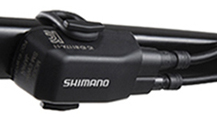
EW-WU101 and EW-WU111 ANT and Bluetooth Wireless Broadcast Modules: These modules are similar to the SM-WEE01 but also include Bluetooth capabilities in addition to ANT capabilities. They require the BT-DN110 battery or the BM-DN100 Battery Mount and cannot be used with the SM-EW67 Front A Junction.
SC705 Alfine Display Unit: This unit displays the battery level and the rear derailleur gear selection. It is powered by the system battery and has a port for the SM-BCR2 internal battery charger / USB diagnostic tool. It is primarily designed for Alfine systems (both 8 505-series and 11 speed 705-series). It is compatible with Ultegra and Dura-Ace Di2.
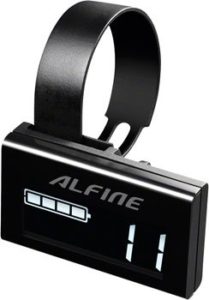
MT800 Digital Display with Bluetooth: Primarily aimed at XT mountain bike applications, this display allows toggling between the 3 synchronized shift modes (where both derailleurs are intelligently coordinated in unison by one pair of buttons, so no need for discrete shifting of the front derailleur.) It also shows battery level, gear position, shift mode and FOX iRD suspension position. The Digital Display required the new BT-DN110 battery. Existing Di2 XT systems are upgradable to be compatible with the new digital display after battery upgrade and firmware upgrade. This display has 3-port Di2 Cable junction and charging port integrated into the back and serves as a Front A Junction.
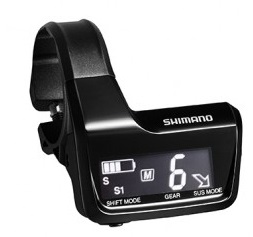
Batteries and Battery Mounts:
The batteries contain the main controllers for the system. It is therefore required to upgrade the battery to get features released in new versions of Di2 (such as Synchronized Shifting that automatically controls the front derailleur based on rear derailleur shifting.)
SM-BTR1 External Battery: This external battery must be used with the SM-BMR1 battery mount. It is removed from the mount and charged using a dedicated charger.
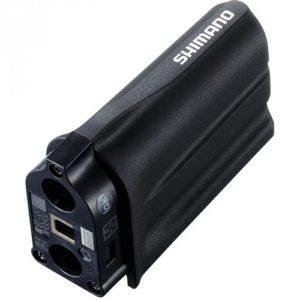
SM-BMR1 and SM-BMR2 External Battery Mount: This mount attached to bottle cage mount points or other dedicated frame mounts. It is available in 3 different mount lengths: -I (intermediate length), -S (short length), -L (long length). The SM-BMR2 is an updated version of the SM-BMR1.
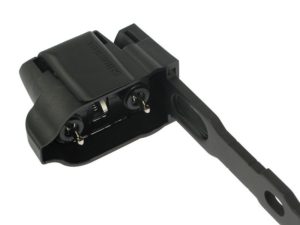
SM-BTR2 Internal Battery: This battery is typically mounted in the seat post or seat tube of the frame. It is charged by plugging the SM-BCR2 Charging Cable/PC Adapter into the SM-EW90-A or SM-EW90-B Front A junctions.
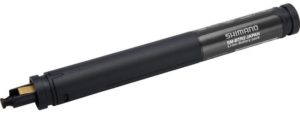
BT-DN110 Internal Battery: This battery is required for Bluetooth wireless units and road groupset Synchronized Shifting functionality.
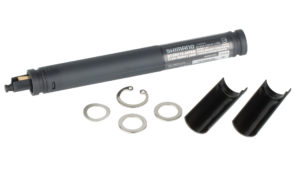
BM-DN100 External Battery Mount: This battery is required for Bluetooth wireless units and road groupset Synchronized Shifting functionality.
Front A Junctions:
SM-EW67-A-E Ultegra 3-Cable Junction: This is the original front junction with 2 integrated cables to connect to the dual control brake lever/shifters. The male cable ends on this Front A Junction will not mate directly to the male cable ends on any of the Time Trial/Triathlon dual control brake shift levers or shifters; SM-JC41 Rear B Junctions can be used to connect this front A junction to TT/Triathlon shifters. This Junction works only with External Batteries, not Internal Batteries.
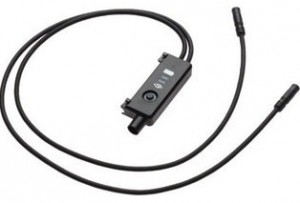
SM-EW90-A Dura-Ace 3-Port Junction: This front “A” junction is most commonly used in road bike setups. 2 ports connect to the dual control brake / shift levers; the third port is for the cable that leads to the bottom bracket junction.
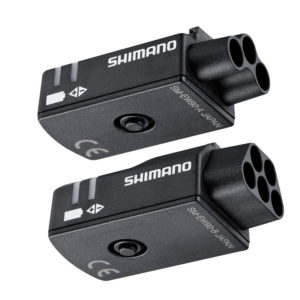

SM-EW90-B Dura-Ace 5-Port Junction: This front “A” junction is primarily used in the Time Trial / Triathlon setups. 2 of the port are for the brake/shifter dual control levers, 2 of the ports are for the aer0 bar bar-end shifters, and the 5th port is for the cable that runs to the bottom bracket (where the B junction joins the wires from the front A junction, front derailleur, rear derailleur, and battery.)
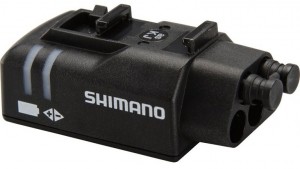
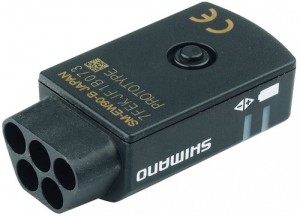
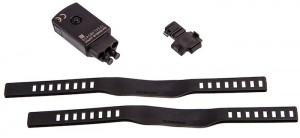
EW-RS910 Internal Bar-end Junction: This junction is installed into the end of a bar or in a dedicated frame port. It facilitates internal cable routing.
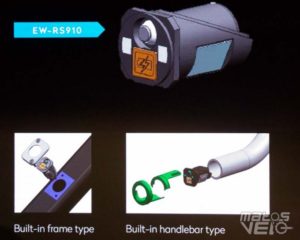
B Junctions:
SM-JC41 Internal Junction: This version has the exact functionality as the SM-JC40 external version, but doesn’t have the mounting tab for being bolted to the bottom bracket or wrapping the extra cable lengths. It has 2 ports on one end and 2 on the other, making it more compact. In addition to being located at the bottom bracket to connect the A junction, battery, front derailleur, and rear derailleur, it can be used at the handle bars to join multiple shifters prior to being connected to the A Junction.
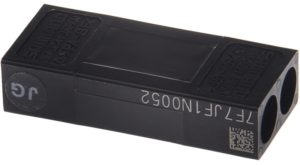
SM-JC40 External Junction: This version is intended to be attached to the frame using the bolt that is commonly located underneath the bottom bracket housing. This junction contains no electronics; it’s sole purpose is to join 4 connectors together, which are usually the wire from the front A junction, the battery, the front derailleur, and the rear derailleur. There are wire holders above the housing to capture the extra wire length by wrapping it back-and-forth.
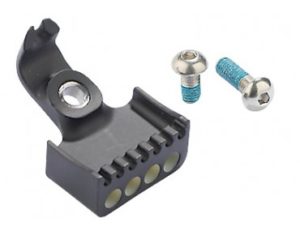
Cables, Grommets, and Cable Remove/Install Tool:
EW-SD50 Cables: These cables connect the front A junction, the battery, the front derailleur, and the rear derailleur to the rear B junction, which is typically located near the bottom bracket (near the cranks.) These are available in lengths of 300mm, 350mm, 400mm, 500mm, 550mm, 600mm, 700mm, 750mm, 950mm, 1000mm, 1200mm, 1400mm.
SM-GM01 Grommet: These round grommets are used when drilling round holes for internal cable routing, or with existing round holes. The required hole diameter is 6mm (6mm = .236 inches. Use a 7/32-inch drill bit and then “wallow-out” the hole to make it a little bigger; a 1/4-inch drill bit will work but is just slightly larger than necessary.)
SM-GM02 Grommet: These 7mm x 8mm oval shape grommets are used in some situations / frame designs.
Shimano TL-EW02 Ultegra DI2 E-Tube Tool: This tool is used to connect and disconnect the Etube wires. They are extremely difficult to connect/disconnect by hand, and pliers or other tools can damage the wires. Don’t get this confused with the TL-EW01 tool, which is for the older 5-wire 7970 cables. (My Dura-Ace TT Dual Control Levers came with one of these tools, but no other components did.)
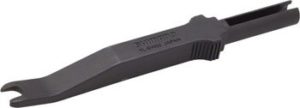
Common Questions (via Shimano):
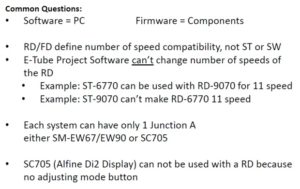
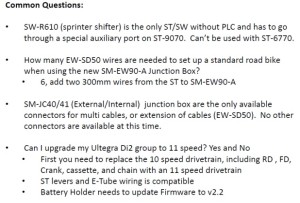
Note: it is not necessary to replace the FD from upgrading from 10-speed to 11-speed.
What Components do I need to put together my own Di2 system?
Because of the huge number and variety of components, it’s very difficult to figure out what is actually necessary and what is optional. So here is a list, for the setup I recommend: Ultegra 6870. It starts from the handlebars and works backwards. (This assumes both front and rear derailleurs, but you actually don’t have to have both; you can pick one or the other and only the corresponding front shifter to go along with it.)
- Any Type of Shifters / Shift Buttons. The Dual Control Brake Levers/Shifters are not required. You can get the just the climbing shifters or Triathlon/TT bar-end shifters, and then potentially add the Dual Control Levers/Shifters at a later point. (The only exception is the Sprint shifters, which require specific Dual Control Levers/Shifters with special ports as noted elsewhere in this article.) Amazon.com link
- EW-SD50 Wires 1 and 2 between the front shifters and the Front Junction A (0nly for some shifters). This is a bit confusing, because some of the front shifters come with wiring attached to them and some of them require purchasing separate wires. In general, most of the stand-alone shifters come with wiring, as do the TT/Triathlon dual control shifters/levers, but the road dual control levers do not. Amazon.com link
- Front Junction A. I recommend the SM-EW90-B 5-port front junction A as it provides the most upgrade flexibility; get the 3-port option only if you’re positive you’re never going to add more shifting components. The older SM-EW67-A-E has 2 wires built-in to connect with each of the dual control shift/brake levers; it doesn’t offer much flexibility or compatibility with a TT/Triathlon setup or adding additional shifters. Amazon.com link
- EW-SD50 Wire 3 between the Front Junction A and the 4-port Rear Junction B connector. Amazon.com link
- EW-SD50 Wire 4 between the Rear Junction B and the Front Derailleur. Amazon.com link
- EW-SD50 Wire 5 between the Rear Junction B and the Battery. Amazon.com link
- EW-SD50 Wire 6 between the Rear Junction B and the Rear Derailleur. Amazon.com link
- Rear Junction B: This is where the wire from the front of the bike is connected to 3 output wires leading to the front derailleur, rear derailleur, and battery. SM-JC40 is for external wiring, SM-JC41 is for internal. Amazon.com link
- Grommets for any place where the wire goes into the frame through a drilled hole. Amazon.com link
- Front Derailleur. I recommend the Ultegra FD-6870 for 11-speed builds or the FD-6770 for 10-speed builds. The Dura-Ace FD-9070 is pretty much identical, just slightly (41g) lighter and 11-speed only. (I do not recommend the Ultegra FD-6770 unless you have a 10-speed setup, because of firmware compatibility issues with 11-speed rear derailleurs. Also, it is an older design than the FD-6870, so it is larger and offers slightly less shifting force.) Amazon.com link
- Battery and Charger. Internal or external, depending on the build. If you have to skill/time/money-to-pay-someone to get everything internal, I highly recommend that option. The SM-BTR2 internal battery has more advanced integrated electronics and is better for firmware upgrades with the SM-BCR2 internal battery charger/PC tool. If you go with the SM-BTR1 external battery, you will need the SM-BMR1 external battery mount and SM-BCR1 external battery charger. Amazon.com link
- Rear Derailleur. I recommend the Ultegra RD-6870 for a new build if you have 11-speed compatible wheels with 11-speed sprockets, or the Ultegra RD-6770 if you have 10-speed wheels/sprockets. The system must be match front and rear derailleurs (both 6870 11-speed or both 6770 10-speed.) Amazon.com link
- TL-EW02 Etube Wire Remove/Install Tool: It takes quite a bit of force to snap the wires in/out. You may think you can get it seated properly with just your fingers, only to then have the wire come loose because it wasn’t fully seated. It’s a good idea to keep one in your saddle bag. Amazon.com link
What wire lengths do I need? This question is impossible to answer correctly, as it’s highly dependent on the frame size and configuration. What I recommend is running string between the component mounting locations to measure the lengths. Be sure to add some extra length, as I find that wires seem to come up short pretty frequently, even when “adding a little extra” to start with. Nothing is more frustrating that having a wire that is 25mm too short. I recommend ordering a few extra wires of multiple lengths and then returning the unneeded/unused wires. As noted above, the standard wire lengths are 300mm, 350mm, 400mm, 500mm, 550mm, 600mm, 700mm, 750mm, 950mm, 1000mm, 1200mm, 1400mm. Do not cut/splice these wires; the connectors on the end of the wires are very small in diameter to start with and you’ll end up with a splice that is larger and less waterproof than you started with.
Acknowledgements: Special thanks to Di2diy for his continued help in the comments. Check out his Ebay store for custom Di2 batteries, harnesses, and components.
Technical Details of the Di2 CANBUS protocol and signaling
Thanks to commenter Ghislain for the details: “I reversed engineered the signal going to the RD. Since I did not have a special tap connector, I could only look at the actual signals in open loop (RD wire disconnected) on the wire going to the RD using an oscilloscope. First, I found that shift up and down are multiplexed on the same wire. A shift down would generate a positive 100 msec clean 8 volt pulse (varies between 50 msec to 500 msec depending on how long you hold the shifter). On the same wire, a shift up would generate a series of 2 msec pulses that would last the same time of a shift down pulse. Therefore, the RD has enough intelligence to discriminate between the 2 types of pulses. When you hold the button on junction A, a 140 msec pulse is generated. But since my RD wire was disconnected, the RD would not go in adjust mode.”
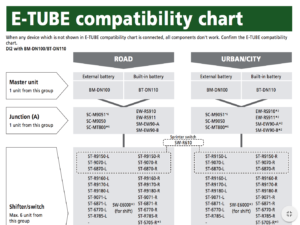
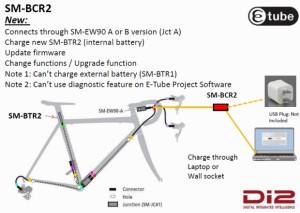
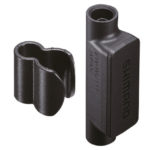
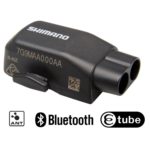
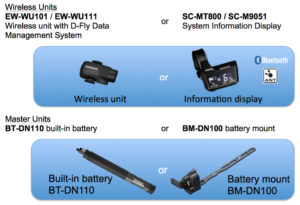
Hi,
I have installed the new BT-DN110 Internal Battery so Ivan use synchro shifting. I have the full Dura ace 9070 group set. However, when trying to change to synchro shift etube project has told me to update fd-9070 and rd9070 to the latest firmware as they can not be read. They are both at the latest firmware level however. Any ideas? 😉
Sorry, have found the older comments on this same topic! It’s still not working then! That’s a bit rubbish really.
Sorry to duplicate the question.
The Junction box A have special method press after Red / Green light flashing then hold button after one red light “keep hold” after light off then OK…. Please try!
I just cam across some SW-R9150 Remote Satellite Shifters (climbing shifter) on a Japanese site. The Shimano website doesn’t have the manual for this yet.
Does this plug into a standard junction? or are these like the “dumb” sprint shifters that only work in conjunction with the STI levers?
I am trying to get a TT bike bullhorns shifting solution (has Magura hydraulic TT brakes)
I am in the same situation. I think R600 climbing switches can plug into a 5 port junction box. I read some online forums suggesting that.
SW-R600 climbing switches can be plugged in anywhere in the system except the special sprint shifter port. they can also be programmed to shift the FD/RD, you can have more that one if you like, and they can be routed through any port i.e, JC41, plugged into open any port.
as near as I can tell the SW-R9150 is like a sprint remote button with a satellite remote base. However I have no experience with this new item, but since its being released as part of the DURA-ACE R9150/R9170 available as a programmable Di2 option system, supporting sequential shifting I would guess it is just a two button option (since thats all you need) that mounts on the HB as pictured on the Shimano site. Also I believe all the firmware supporting compatibility between older Di2/e-tube hardware is not released so its not clear how they can be used. I will get a pair and report back when I have an answer.
looking at the compatibility chart Shimano shows thy are compatible with road or MTB
http://e-tubeproject.shimano.com/pdf/en/HM-CC.3.2.0-01-EN.pdf
Just fitted the R9150 shifters. They work perfectly.
Also fitted the bluetooth battery holder and Bluetooth module.
Now just waiting for Shimano to release firmware 3.0 for the derailleur so I can get synchro shift!!
For the 9070 DI2 system, how can i pair it with a 11-30 cassette?
Great site!
I have Ultegra Di2 6870 derailleurs with R785 hydro disc brake shifters. I added the D-Fly EW-WU101 to it.
A few questions (in descending order of priority for me) that I’m hoping you can help me with regarding the R785 / Di2 system:
1) Can buttons be added to switch screens on the cyclo-computer? Possibly the SM-EW90-B 5-port junction A — could those buttons be re-programmed to switch screens on the computer instead of being climbing shifters?
2) Is it possible to check the Di2 battery level from my cyclo-computer?
3) Is it possible to reprogram the front shifter to reverse the buttons?
Currently, my D-Fly investment only shows what gear I’m in. That’s nice, but not on my list of desired functions.
Thanks for the help!
Hi, quick question.
I have a Ultegra di2 6870 groupset right now. And I want to add ANT+ function. If I get EW-WU101 and NOT the BT-DN110 battery, will it work on ANT+? Reason being, I want to keep the option of adding Bluetooth in the future.
No, the EW-WU101 needs the BT-DN110 in order to work.
Just tried it, WU101 and the old battery and can’t even shift. No problems when using a DN110. They are blocking the use of his combination, for some reason.
have a shimano ultegra di2,
I have a problem,when check the battery charge i see the normal green led but then i see both red and green led for 1 second.
where is the problem?
I have same issue. Hopefully someone knows why.
I have this issue too, it seems to be a bug/glitch in the latest update, hopefully it will be corrected in the next update and maybe – fingers crossed – we’ll also get the intellishift update that works 🙂
I thought it was an indication of the system being ready for Bluetooth pairing, ie. from the Shimano iPad app. Pressing the button for 0.5-1.0 second enables this state. I need to test if the blinking correlates exactly to this though. According to some of the comments above, it seems to do it even if you don’t have a WU101, ie. you can’t actually do the pairing.
0.5-2 seconds it is, then enters pairing mode for 15 seconds. I see no way of checking the battery level from the ew90 anymore, at least not when using the new battery and a wu101. The iPad app will display battery level graphically though, when connected.
I keep trying to unsubscribe but can’t find any link to do so. Could you please delete my email from your list? jimg
Hi Guys,
I’ve recently changed my 6770 system to have the more recent EW90 junction box. I still have an external battery, but it would be good to be able to charge with the charger that plugs into the EW90. But, when I plug it in I get a flashing red light, when I would assume a solid light if it were charging.
Firstly, is it possible to charge an external battery with the charger? And secondly, what do the lights on the charger mean?
Thanks all.
To use the E-Tube Project for Smartphone, will I need the EW-WU111 Wireless Unit.(My bicycle with EW-WU101 Wireless Unit currently works fine with E-Tube Project for PC.)
Hi There,
with my EW-RS910 bar-end-junction there is a rubberband like thing included – can u tell me what it is for? Is it for wrapping the unit with in to better fit/hold in the bar-end? Thank you in advance! Andy
You can see the installation procedure in the tech docs: http://si.shimano.com/pdfs/um/UM-71J0A-001-00-ENG.pdf and pages 55-58 here: http://si.shimano.com/pdfs/dm/DM-R9150-03-ENG.pdf
I received my Wireless Unit EW-WU111 yesterday (16 Feb 2017). It failed to pair with E-TUBE PROJECT for Smartphone on my iPhone 7 Plus. When I unpaired my Apple Watch then E-TUBE PROJECT for Smartphone seems to work. But when I (re)paired my Apple Watch then E-TUBE PROJECT for Smartphone fails again.
Unless something has changed, Bluetooth can only pair with one app at a time.
Hi,
I have a general question. I am building a s-work venge ViAS just got the frame, however; i want the same Di2 system it originally comes with. Do you know what Di2 system i need for this frame? Thank you
You can choose 6870, 9070 or 9150. Not sure if this is the answer you want.
Are the e-tube cables on the SW-R671 remote TT shifters (right hand, two button design) long enough to reach through a clip on aerobar all the way to plug into one of the right shifter ports? Or is a new Di2 junction box on the stem with 5 ports needed as well?
Chris
The wires are around 285 mm long. I think I have the R-600 shifters. It is a tight fit on my TT bike from the bull horn to the 5 port junction on the stem. I doubt if it will come all the way to the shifters on the handle bars from the aero extensions. Somewhere in this thread there are links to posts which discuss extending the length by splicing the wires with some extensions.
5 port junction might be easier way to go.
Can I use a 9100 di2 rear derailleur with a 9000 di2 group? I want that 30 tooth cog 🙂
If you’re running Dura Ace then 28 is plenty big enough 🙂 #Rule5
Well, yea. But hey, why not opt for the Ultegra Di2 RD and run the 32t x 11t cluster. Pro’s have been using that RD for some time. Oh, it is also significantly cheaper!
28t may be enough but if you want to climb long and steep having the option of bigger rings on the back is always a plus.
Enjoy your Di2.
The Ultegra Di2 RD is a definite possibility.
Was just wondering if the 9150 was compatible. Is it just plug and play?
I love the idea of a mid-compact (52-36) with an 11-30 cassette. Can basically use it for everything.
As long as your firmware is current on all components you should be good to go.
Di2 Rocks.
Hello.
With the new combination of BT-DN110, EW-WU10 and E-TUBE on IPad, will that eliminate the need SM-PCE1 ?
No the SM-PCE1 is required to provide an error check and it also tells exactly which component is faulty. Thus you are saved a lot of trial and error!
Well actually you can Make error check on all or individual components, by E-TUBE on the iPad as well. I tested it myself yesterday. So I am wondering what is the benefit by SM-PCE1
I have the E-TUBE app on my iPhone, here you can customise and update software but can’t do an error check.
Similarly on my windows pc I can do all above via the SM-BCR2 battery charger but for an error check it requires the PCE unit
With the combination BT-DN110 and EW-WU101 I am able to do error check by my iPad.
The option looks like this.
https://gzmyu4ma9b-flywheel.netdna-ssl.com/wp-content/uploads/2017/02/Shimano_E-Tube-app_wireless-bluetooth-Di2-customization_MTB-error-check.jpg
i can confirm re the error checking on the Ipad.
My big question is: Does anyone know when Shimano will release firmware version 3.0 for the derailleurs so I can get SYNCHRO shift working on my TT bike!
Have setup some new SW-R9150 climbing shifters and they work great.
Shimano knows, but this is what they tweeted about 3.0 a couple of weeks ago: “We are working on this but can not give a date yet. Please have a bit of patience.”
https://twitter.com/ShimanoROAD/status/835070381593604096
You mention a typical battery life of 1500 miles. Is that true of the seatpost battery? I have a relatively new bike with UDi2, and I find I need to charge every 400 miles or so (with about 25% battery life remaining). It may be a function of where I live, as very little of our riding is flat, so I’m shifting frequently. And while I’m here, may I say thanks for this post. Very impressive. As I told a friend, it’s everything one could ever want to know about Di2… and then some.
One more question. I would like to put XT-Di2 on an older bike. Can I use the SM-BTC1 bottle cage side battery mount with the new BT-DN110 BT battery.
Synchro shift now available for Ultegra Di2 and Dura Ace 90xx Di2! New app and firmware just posted at the Shimano etube site!
Updated app for Smartphone and firmware for FD-6870 and RD-6870-GS to version 3. Finished customization but synchro shift not working! Tried E-Tube Project for PC with same results.
Yeah me too.
Got it all setup but how is it activated??
I tried pushing the button on the 5 port block
Double click the reset button!
Problem solved 🙂
Works great!!
There’s even an updated manual for road synchro:
http://e-tubeproject.shimano.com/pdf/en/HM-R.3.2.1-00-EN.pdf
Didn’t see anything about double-pushing the reset button though. Is a double-push just switching between shift modes 1 and 2 maybe? Whatever you have them setup as.
Hi Tony. Please elaborate. Which reset button? On the bike or on the app? Thanks.
I have the SM-EW90-A Junction A.
Never mind. It works! 🙂
Hi. How do you swap between the 3 modes : manual shifting, semi-synchro and full-synchro ? Is it a “double click” each time ? Does the LED shows the selected mode ? IT is for an Ultegra 6870 groupset.
Thanks
Yes what do you mean by reset button? Is it the button on the front junction SM-EW67-A-E?
I have been away and RTFM, 🙂 Just need to rechargs my laptop to sort it!
What “Reset” Buttton (68xx Ultegra with SM-EW90 -A) .Have updated firmware but a, cannot get either synchro mode to work and b, would also like to know how to swap modes if this is possible Thanks
It’s the button on the junction box. Double clicking it switches modes between full sync, semi sync and normal shift mode.
Aah, double-push circles between the three modes (S1/S2/normal), both leds blinking once, twice or three times after each as an indication of the mode. Too bad my EW90 isn’t in a place accessible while on the bike. I would have to stop to do it. Kind of ok, but would prefer the possibility to switch wirelessly, using a bike computer.
If you have a newer Garmin, you can use that to change shift modes wirelessly. My Edge 1000 with latest firmware does that. As well, it shows when a front shift is about to happen automatically.
I have updated all the newest firmware on my 9070, but there is no any indication by double clicking the junction box button. Do you need to use the new DN battery by activating the synchro shift?
You need the new battery.
Wondering if anyone on hear can help. I had a weird mechanical yesterday. I was going up the hardest hill i have local to me, (ends at about 20%), so was pushing hard in the big cog at the back (28). When I got to the top, i couldn’t change down at all, I spent 5 minutes checking connections on the roadside and trying to get it to go into recovery mode (Hold the button down for 5+ seconds right?), but nothing. Gave up, and turned around for the quickest way home, and halfway down the hill it shifted three cogs down and everything returned to normal.
ANy idea what could have caused this, and what to do if it happens in the future?
I updated my 6870 firmware to 3.0 to see if it would stop the red light from turning on briefly after a battery check shows green. However, it still does this after the update. Everything still works OK.
I have the Di2 XT components to run as a 1 x 11. XT displan, XT shifter, XT rear deraileur, etubes connected and battery charger plugged in. The only thing is that I have the SM-BTR2 Internal battery. I thought I could use this if I was not going to use the 2 x 11 or bluetooth. The charger does not show a charge. The display does not light up. I’m going to get the proper DN-110 battery, and hope that works, but do you know if this could be the issue?
Thanks,
Is everything updated to the latest version of firmware?
Carlton will the swr671 bar end shifters work with 11 speed components. Cheers.
Yes, with firmware update.
Will they shift at all before the firmware update?
I am struggling to update the firmware. The e project software is not recognizing the sw671 shifters and then tells me they are not campatible but no option to update them. Told me to update to latest version of e tube software which I was already running. Confused.
Try disconnecting different components to isolate the shifters. That may enable the firmware update to go through. Check the Shimano site to make sure there is a newer firmware revision.
Any chance you have driver files for the SM-PCE1? Windows is having a hard time installing the driver. It detects the device but even after installing various versions of the E-Tube project it can’t seem to find the driver required. I’d like to do a manual driver install if possible. Shimano was not able (willing) to provide me with such files.Thanks
I have tried to update my Ultegra 6770 group, but the update failed. Now I can´t use the left shifter (ST-6770-L) E-tube can´t find it and I don´t know how to reinstall it.
Ca anyone help.
I have the same problem, have anyone solved this isue?
This site is incredibly useful – thanks so much!
Would like to know best location to mount a EW-WU111. I have a 2015 Tarmac which is setup Di2 internal cabling. I understand it can go anywhere in line, is one place better than another, down tube vs seat post below internal battery?
It doesn’t really matter where it’s located in a carbon frame. Aluminum internal mounting may result in poor signal strength.
Will the SWR671 bar end shifters work with 11 speed.
Cheers.
I hvae some questions concerning the SM-EW90 modul. I updated all my DI2 Ultegra 6870 components with the latest FW and configured my sychrinized shifting. I also installed the new Battery and the DFly wirleless modul. Everything wokrs fine. I have some trouble with the connection to my Garmin 510 (FW 6.1)but that is another topic.
What I want to know is some information about the several blinking modi of the SM-EW.90 modul. I know the status blinking for battery control adjustment mode and shifting modes. But there even more modi. For example:
one led blinking green parallel the other blinking red (Blue tooth mode????)
both leds blinking red (I don’t know)
one led blinking red the other led is always red (I don’t know)
Can you help me. Is there an overview abou all modi. That would be great.
Thank you for helping the german DI2 community.
Kind regards
Gerhard
I have an older version, circa 2012, ultegra Di2 10 speed with external battery mounted on a Trek Madone 5.2 under the bottom bracket. The bike has not been used in a couple of years but I was still able to charge the battery and get a solid green light at the front junction box. Pressing shifting paddles for either FD or RD does not elicit any response from either derailuer. I also tried to hold reset button for 5 seconds till I had a solid red light and turned the cranks with no response from derailuers. Since power is obviously getting back and forth between battery and shifters, am I correct in assuming that the problem must be with the internal junction box inside the bottom bracket housing?
Most likely it’s a junction box or cable. You really need the PC software and adapter to troubleshoot. Plugging and unplugging and swapping cables is your alternative.
Hi all
I’m sure this has been asked before, but I would like to know if it is possible to run a 12-25 cassette with the RD6870 gs (long cage) without any problem?
Thanks.
Mark
Yes, it should work.
Thanks I’ll take that as a definite.
I just upgraded to a DI2 disc with an internal BT-DN110 battery and ultegra fd and rd. I was trying to update the firmware and the battery update failed. Now the e tube software will not recognize any of my parts. Any advice on how to rectify this would be appreciated.
Try connecting the battery directly to the PC adapter via a junction with nothing else connected.
I tried that by removing connectors from the shifters and FD and RD. My e tube software shows a red box in front of both the battery and junction.
Check the chaege level of your battery. It is important the battery has a full charge before making firmware upgrades.
FYI the Shimano Ultegra 6870 Dealer’s Manual link needs updating to http://si.shimano.com/pdfs/dm/DM-UL0001-03-ENG.pdf
is the Dura Ace FD-9070 fr derailleur compatible with Ultegra ST-6870 shifters?
Hi, I currently have the external fit Ultegra Di2 groupset, with a SM-BTR1 battery mounted just below my bottle cage. Im planing on buying a new frameset and moving all my components across. As nearly all new framesets will take an internal Di2 install, what would I need to convert mine from an external fit to an internal fit? Would I just need to buy the SM-EW90 Front Junction underneath the stem, the BT-DN110 Internal Battery and a SM-JC41 Internal Junction inside the bottom bracket? Then update the firmware? Does the internal battery come with a rubber o-ring to hold it in place inside the seat tube? If I use the SW-R600 Climbing shifter, can I use the 3 port front junction box (in series) or will it only work with the 5 port (in parallel). Thanks for the help.
Benjamine, your description is correct on the components needed. The internal battery comes with a snap ring for seat post installation; I’m not sure how universal it is. The climbing shifter will work with either config mentioned.
Do you have any information as to what other shift modes Shimano may offer in the future? They don’t seem to have any easy way to offer suggestions. I can see where it might be helpful to be able to have both semi and full sync active at the same time. And, although the drivetrain doesn’t know your cadence, the capability to get cadence info from some other source and do cadence-based shifting would be nice to have.
@Don … An automatic transmission will need more inputs than just cadence. It will need to know what power output you’re wanting. For example, using the same cadence… on the flat with a tailwind I could easily cruise in a hard 50/14t gear at 20mph+ (around 140W) while uphill I’m spinning away in a 34/28t gear at 250W+ and 9 mph. Then to add complexity, what zone of power are looking to use at that particular moment… Recovery, endurance, tempo, 5 min max effort
@Benjamin…I agree with most of your comments regarding an “automatic transmission,” but that wasn’t what I was referring to in my post. I was just seeking a simple cadence-based shift mode. The big issue I see would be in the transitions to/from steep uphills or downhills where your cadence would drop dramatically (maybe to zero on the downhills). A rider would typically shift in advance whereas a cadence based shift mode would not have a prediction capability.
Regarding your examples, one could ride that way (low cadence in a level, tailwind situation and high cadence on a steep hill climb), that is not generally the way I ride. I think my preferred cadence would be in a narrow enough range (10-20 rpm) that cadence-based shifting should work in that scenario. Where it would fail, though, is if a wanted to switch, for example, from seated higher cadence climbing to standing (not attacking) tempo just to change up.
Regarding handling different power outputs – you determine that by how much effort you put into it. If you are doing a recovery ride, a cadence-based mode would shift to the appropriate gear to give you your desired cadence at the power you choose to put out. If you’re riding tempo, it would shift to a higher gear (since you would be spinning out on the lower gear with your higher power output). As in the synch mode, you could also adjust the cadence where up and down shifting will occur if desired for different rides with different goals.
Don, for the exact same cadence, sometimes you want a hard gear while sometimes you want an easy gear. It depends on lots of different factors like wind, hill gradient, road surface, drafting, effort zone.
The control units for automatic transmissions on cars and trucks are complex in their design and make calculations based on many input parameters such as engine speed, wheel speed, engine load, throttle position.
In my own opinion Di2 is quick, reliable and ergonomic that im happy to use it. Sometimes my sweetspot has layed inbetween gears on a big cassette (wider ratios?) and it’s been handy to flick inbetween two with a twitch of my index finger.
See if Baron Controls Proshift does what you want. proshiftracing.com/
Hi,
I have a complete DA9150 installed with all the components.
However when in manual model (M) when i am in the smallest front chainring (36) it will not let me shift to my smallest 2 cogs on my rear cassette.
I know it protects it but its uselful when removing back wheel.
Is there anyway to disable this feature?
I have a weird issue with my 6870 Rear derailleur where it was working perfectly for a couple of months but this morning it just started trying to automatically change gears every 2 seconds. It was while i was out riding and to the best of my knowledge it wasn’t hit or anything. Have you ever seen this before? it is literally trying to change every 2 seconds.
Are you going to revise anything on this page to incorporate material about the new EW-RS910 bar end junction box that would replace the older EW90 junction-A box?
On that topic, can the EW-RS910 bar end junction be used with 9070 DI2?
It is compatible with all etube systems, 6770,6870,9070..etc also it’s not a “replacement” just another option, and only compatible with bar/stems that allow for internal cable touting.
I just built up my cross bike with an Ultegra 6870 RD and FD, with a set of 6770 shifters, the EW-RS9150 A-junction box and the new EW-WU111 transmitter. Once all firmware is updated, it all works well. The RS9150 is great for cleaning up the cockpit, but you do need a set of compatible handlebars that will allow you to route the cables internally. I ended up getting a set of Chinese carbon bars, but the internal routing is not for the faint of heart. Also, you’ll either need several different cables, or one of the new Y-cables. I would recommend getting the longest one, as it will make things easier. Mine ended up being too short, so I had to do some soldering to increase the length. There’s a good video on youtube showing how to set up the RS9150 without the d-fly transmitter in the front, if you want to mount it elsewhere in the system (inside the frame, etc.)
Hi Carlton Bale!
I have an existing 9070 setup (Canyon Aeroad Di2). Assuming I have all existing components updated to the latest firmware, Can I just plug in an EW-RS910 into the loop and expect it to work?
I’m assuming that I will retain the existing EW90 junction box A…. or am i required to remove the old junction box?
Thanks!
You can only have one junction in the system, so the EW90 will need to be removed. Also be aware you will need a special stem and bar that is compatible with the internal routing, an update of the system may also be required.
> DI2DIY said: White to red, black to shield
Just to be sure: The polarity of the EW-SD50 is black=negative, red=positive?
Background: I need to hack my own battery pack because of my LightSKIN. The embedded electronics in this seatpost are using up all available space but by swapping the batteries to Li-Ion I can power both Di2 and LEDs.
Yes red+ blk-, charger white+ sheld-
I have successfully downgraded all the firmware to mix and match 6770 / 6870 / 9070 items. It took me a while and it is not as easy as expected to find the right file for the right version. If it is in your interest Mr Carlton Bale I could do you the favor and write down a “how to downgrad Di2 firmware for dummies” blog. You can contact me if you like…
I want to know, even if Mr Carlton Bale does not. Please and thank you.
-install latest etube
-go to c/programdata/etubeproect/fw place the old fw files of etube 2.5.2 here
-check for the parts you want to downgrade which file they need
-rename the old fw like they were an update (e.g. smbtr2.2.0.1 to the fw name your part has and increase the last digit by +1 = smbtr2.2.0.1)
-disconnect to the internet
-run etube, connect only the part you want to downgrade, let etube find your renamed file and do the upgrade – if successful directly disconnect the part from etube
-parts that need fw from etube 2.5.2 are STIs, Battery and battery holder anything else can run up to date fw
-sometimes there are several files for that could be loaded for a part that are just little different in the name, you need to try and error which is the correct given name to force the downgrade
– RD 6870 takes firmware from file for RD 9070 by the way
– I have used sm-pce1 not sure if it works with the other connection tool
– I can make it more obvious with pictures in the following days. So far 100% success with every part! Just a little try and error to find the right name for the file.
Greetings from Germany
JNJ
The general strategy is as I expected. In my opinion the exact filenames and revisions needed for each particular part is what will allow others to avoid the trial and error procedure. A table showing the answers to “find the right file for the right version” and the versions needed would keep others from having to repeat your trial and error.
And for me (probably unlike most modern internet users) something like this is best shown with text including the above, rather than pictures. I like to get as much information on a single screen as possible.
Can I “upgrade” a derailleur or shifter through etube if I do not have a battery connected?
One question, why?
Wouldn’t it just be easier to just buy compatible components and not fool around with all the silliness?
Well I guess that’s two questions.
Well if you need to spend $¥£€ for new junction Box for an internal battery or a new Front Derailleur for 11speed. Then it is nice to have the choice to either downgrade or to spend some cash.
Using Ultegra 6870. I just received the SW-900 shifters and connected to the spare E-tube port on the RH shifter and it didn’t work. I then thought I’d connect to E-tube and see if it was configurable in there. The software updated the FW for all components and now the SW-900 shifter works but my front derailleur doesn’t. Any ideas??
is you RD $ FD both 6770 or 6870? you cannot mix 10&11 speed RD&FD.
Yeah both 6870.
actually there is no such shifter “SW-900 shifters” what do you actually have
SW – R600 sorry brain fart.
within the software options check the shifter options under customize. there are settings for the R600 and the left and right shifters to program the button function for left, right, and remote. check that all the options are set for the FD for the left shifter, and the remote.
I got a PCE connection direct to the FD-6870 and reset the FW. It must’ve got bricked on the original update. Praise the lord for the PCE unit as this sort of diagnosis can’t be fixed with the charger unit connection to E-Tube. Anyway I thought I’d put this up here for other people to learn from…. I found scant information in regards to FW update faults. Thanks